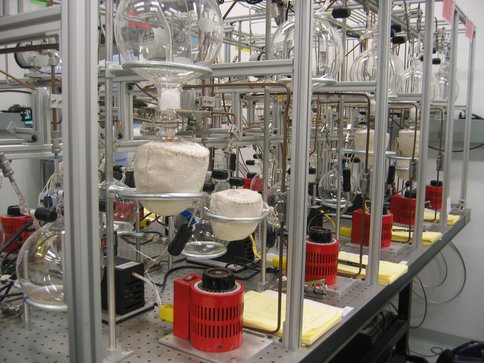2013 Annual Science Report
 NASA Goddard Space Flight Center
Reporting | SEP 2012 – AUG 2013
NASA Goddard Space Flight Center
Reporting | SEP 2012 – AUG 2013
Fischer-Tropsch-Type Reactions in the Solar Nebula
Project Summary
We are studying Fischer-Tropsch-Type reactions in order to investigate the formation of complex hydrocarbons by surface-mediated reactions using simple gases (CO, N2, and H2) found in the early Solar Nebula. Although several theories exist as to how hydrocarbons are formed in the early Solar System, the compelling nature of this type of reaction is that it is passive and generates a wide variety of complex hydrocarbons using commonly available components (gases/grains) without invoking a complex set of conditions for formation. This method for generating hydrocarbons is important because it provides insight or potential as to how comets, meteorites, and the early Earth may have obtained their first hydrocarbon inventory. From this study, we have expanded the FTT experiments into several related areas of interest, of which the formation of amino acids and the trapping of noble gases are two examples.
Project Progress
During this performance year, the multiple (10-set) FTT system became fully operational, and several students assisted in setting up and running FTT experiments (Figure 1). We started a program to investigate FTT efficiency and rates, using commercially available Fe-based catalysts (Fe, magnetite-Fe3O4, hematite-Fe2O3, goethite-FeO(OH). Additionally, we began long-term low-temperature (200-300°C) FTT experiments using synthesized metal-silicate dust that included noble gases in the mix; two of these experiments are ongoing and have been running continuously for over eight months.
Dr. Hany Sobhi (Coppin State University) joined the project during this reporting period. Dr. Sobhi was supported through the 2012 NASA Astrobiology Program Minority Institution Research Support (NAP-MIRS) Program. Through our collaboration, we mentored two Coppin undergraduate students Nathaniel Whitt (Fall semester) and Annette Butler (academic year). Their task was to continue the exploratory studies started the previous summer on the efficiency of the commercial substrates. Preliminary results from Dr. Sobhi’s subsequent research on the reacted grains suggest formation of iron/carbon clusters.
The summer of 2013 brought us the efforts of an excellent student, Meghan McCarthy from Harvard University. Meghan was selected as one of the Undergraduate Research Associates in Astrobiology (URAA), a program organized by the Goddard Center for Astrobiology (GCA) of which we are members. Meghan systematically explored the similarities and, in greater depth, the differences between iron and magnetite as FTT catalysts through temperature and reaction cycle. She clearly demonstrated that the organic coating developed on the grains through FTT reactions served as a ‘better’ catalyst than did the original grain surface. Her findings provide a basis for further exploration, particularly that of possible amino acid formation, as well as whether the catalyst’s initial oxidation state may control the end-state reaction products.
-
PROJECT INVESTIGATORS:
-
PROJECT MEMBERS:
Joseph Nuth
Project Investigator
Frank Ferguson
Co-Investigator
Natasha Johnson
Co-Investigator
Aaron Burton
Collaborator
Jamie Cook
Collaborator
Jason Dworkin
Collaborator
Hany Sobhi
Collaborator
-
RELATED OBJECTIVES:
Objective 1.1
Formation and evolution of habitable planets.
Objective 2.2
Outer Solar System exploration
Objective 3.1
Sources of prebiotic materials and catalysts
Objective 3.2
Origins and evolution of functional biomolecules
